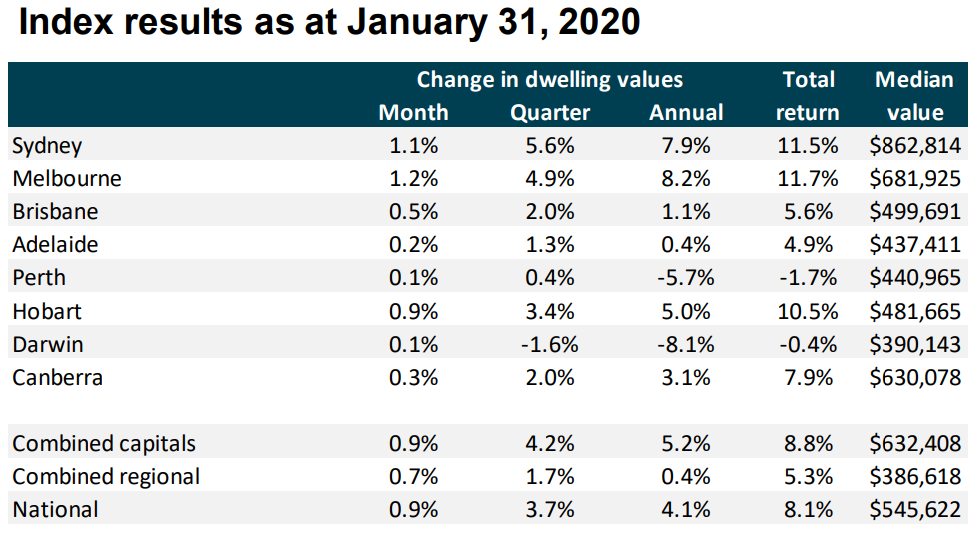All capital cities experience upward trajectory
Australia’s housing market is still going through a rebound, with a 0.9% increase in the home value index during the month of January.
The Australian house market continued its upward rise in January 2020 across all capital cities according to the latest CoreLogic data.
It should not come as a surprise that Sydney and Melbourne were strong performers and were up 1.1% and 1.2% respectively, even with the slowing growth pace from December 2019.
Even Perth and Darwin’s property market saw an increase with both cities rising by 0.1% month to month.
Sydney, Melbourne and Canberra maintain their spot as expensive cities and have the top three median dwelling prices – Sydney’s median value was $862,814, Melbourne’s was $681,925 and Canberra’s was $630,078.

Source: CoreLogic Hedonic Home Value Index, January 2020
For buyers on tight budget, look at lower quartile housing values
According to CoreLogic data, the gains in house prices are mainly happening in the upper quartile value range, with properties in the upper quartile rising by 1.2% compared with a 0.2% rise in the value of property in the lower quartile.
Looking at national annual data, there was an 8.5% increase in the value of upper quartile property while lower quartile saw a decrease of 0.2%.
Sydney’s top quartile market had a 10% lift in dwelling values for the past 12 months, while it’s lower quartile market only grew by 3.4%.
Similarly, Melbourne’s top quartile market experienced an 11.5% lift, while it’s lower quartile only grew by 5.6%.
While Brisbane experienced a lower increase than Sydney or Melbourne, it’s top quartile market still grew by 1.3% compared to the lower quartile growth of just 0.3%.
The lower quartile values of the capital cities provide a good entry point into the property market.
For instance, the upper quartile house value in Melbourne is $1,180,110 while the lower quartile value is $614,330, saving a homebuyer $565,780.
Melbourne’s unit prices
Melbourne’s unit prices have also skyrocketed, with the median unit price reaching $549,701 in just three months to December 2019, according to Domain House Price Report.
Looking at the CoreLogic Hedonic Home Value Index of January 2020, it is now more expensive to buy a unit in Melbourne than anywhere, besides Sydney and Canberra.
Darwin: Population decline
A curious phenomenon happening in Darwin is that its population is actually in decline!
According to the Australian Bureau of Statistics 2018 data, Darwin lost 355 people from its population of 148,564.
Darwin is also the least profitable city in terms of property sales, as nearly half the dwellings on the market are selling at loss, making it the weakest performing capital city for the quarter at -1.6%.
However, Darwin still has the highest rental yields at 5.8% p.a.
Australian housing market trends 2020
Poperty trends that will likely shape Australia’s housing market in 2020.
- The interest rates will remain low, with speculation that the Reserve Bank of Australia (RBA) would cut the cash rate further if unemployment levels remain high.
- There will be stronger population growth in smaller cities or regional towns due to soaring property prices of Sydney and Melbourne. As a first home buyer, it might be a better option to look towards other affordable capital cities and suburbs.
- People are more in favour of using public transportation than cars – which means home buyers will favour properties in well-established suburbs closer to public transportation and new developments might not need car parks and opt for spaces for rideshares and bikes.
- The demand for medium-density housing will increase in established suburbs, which are in undersupply at the moment. Homebuyers are looking into larger apartments that have three to four bedrooms with space for gardens or playgrounds.
- Consumers would now prefer more energy-efficient and well-designed homes to better suit the warmer climate. Furthermore, the government may change the building standards due to the recent apartment defects and flammable cladding disasters.
- The number of homes rented privately has slowly risen from 18.4% in 1994 to 27.1% in 2017. If the trend continues, then it’s estimated that 31.5% of households will rent privately by 2030.
- The aging baby boomer population would require housing accommodations that better suit their needs, with the Aged Care Financing Authority estimating that 76,000 new residential aged places are required to meet the growing demand. Existing homes might be renovated or new dwelling would be built with fewer stairs, access to elevators and accessible bathrooms.
Are you looking to buy property in 2020?
It’s best to get pre-approved for a home loan before you start looking for a property if you don’t want to miss out on your ideal property.
Whether you’re buying your first home, or a seasoned investor looking to grow your investment portfolio, our award-winning brokers are here to help.
Call us on at 1300 889 743 or fill in our free assessment form to get pre-approved.